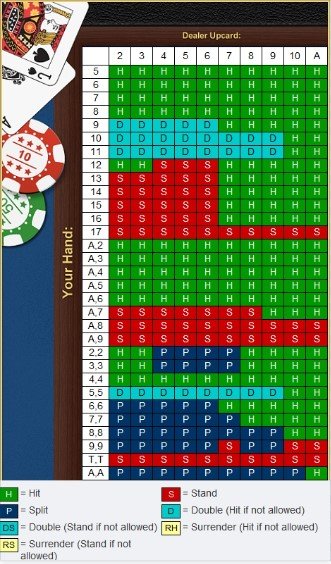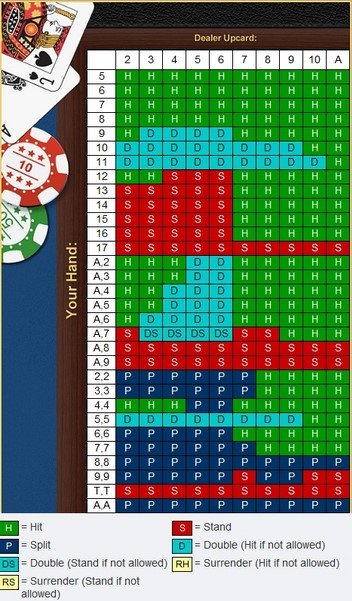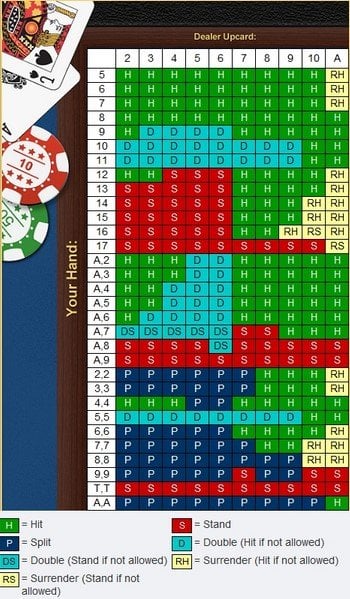Blackjack Variants and Versions
Blackjack is one of the most popular gambling card games. It has been played all over the world for centuries, and over this time, different variations of the game have developed with new rules and side bets. When you play blackjack online, you will notice that most online casinos offer different variants of the game. Below is a list of the most popular blackjack variations.
European Blackjack
European blackjack is a popular version of the standard blackjack game. It offers players an exciting game that is easy to play. The objective of the game is identical to most blackjack games where the player needs to beat the dealer by reaching a hand total of 21 points or get as close to it as possible.
The game is available in many online casinos and all online casinos offer this game. It is a game that is recommended to players that have some experience playing blackjack and are interested in trying a new and exciting variation.
European Blackjack Rules
The game is played using only two standard decks of cards. The game starts with the player being dealt two face-up cards. The dealer is dealt only one face-up card and does not get a second card at this stage of the game. If the dealer’s only dealt card is an ace, the player is offered the option of making an insurance bet at half the cost of their original bet. The insurance bet is only resolved at the end of the hand.
Whether the player decided to make the insurance bet or not, play continues and it’s the players turn to make a move. The player is only allowed to double down on hands with hard totals of 9, 10 or 11. It is allowed to split all pairs except two different 10-valued cards. No doubling is allowed after splitting. The player is allowed to split aces and draw on split aces. No surrender is allowed.
European Blackjack Dealer’s Rules
The dealer must stand on all 17 (soft 17 and hard 17). The dealer will only be dealt one card. That card is seen throughout the game. If that card is an ace the dealer will offer the player insurance. The insurance bet is only resolved at the end of the hand as the dealer is not allowed to draw its second card until after the player finished making their move.
In case the player goes bust there will be no need for the dealer to draw any more cards unless the player took insurance. In this case the dealer will draw another card to see if they hit a natural blackjack. If they did then the player will be paid the insurance bet.
European Blackjack Strategy

Vegas Strip Blackjack
Vegas Strip Blackjack is the most common type of blackjack named after the big casino strip in Las Vegas. It is a game that is offered in most land casinos and online casinos. Some of the rules might vary slightly but the main principles of the game always stay the same. You would be wise to check the exact rules of the game in the casino you are about to play at.
In this game the objective of the game is identical to most known blackjack versions. You play the game against the dealer and your main objective is to beat the dealer by reaching a total hand value of 21 points or getting as close to that total without going over it.
Vegas Strip Blackjack Rules
The game is played with four decks of cards. The dealer deals you one face up card and then deals themselves one face up card. Then the dealer deals you the second face up card and deals themselves a second card only this one is facing down (hole card).
In case the dealer’s face up card is an ace the dealer will offer you insurance. The insurance bet will be to the value of half your original bet. The dealer checks its hole card to see if they have a blackjack. If they do then you lose your original bet and win the blackjack bet.
In case where the dealer’s face up card is a 10-valued card they would also check their hole card to see if they hit a blackjack, however no insurance is offered and if the dealer reveals a blackjack you lose your bet.
When the dealer does not have a blackjack the game continues and it is your turn to make a move. You are allowed to double on any two cards and you are also allowed to double after a split. Splitting is allowed up to three times (so in total you can have a maximum of four hands), but aces are allowed to be split only once with only one card dealt for each hand after the split. A split ace and 10-valued card hand counts as 21 but does not count as a natural blackjack.
Vegas Strip Blackjack Dealer’s Rules
The dealer must stand on all 17 valued hands (soft 17 and hard 17). In case the dealer busts you would win your hand even if it has a low hand total. If the dealer does not bust out of the hand then both your hand and the dealer’s hand totals are compared in order to see who reached a hand total that is closer to 21. In case both hands have an equal total then the round is declared a Push (tie) and your original bet is returned to you.
Vegas Strip Blackjack Strategy Chart

Double Exposure Blackjack
Double Exposure blackjack provides players with a few interesting twists on the usual blackjack version that is so familiar and liked. This version of the game is called ‘double exposure’ because both the dealer’s cards are exposed (sometimes this game is called Face Up 21). This presents the player with a big advantage and the casino is compensated for this player advantage by having a few rules that tip the house edge back in its favor.
You can play this game in most online casinos and in many land casinos in the US and Asia. In this game you play against the dealer and your objective is to beat the dealer by having a hand total of 21 or as close to 21 as possible, while the dealer’s hand is lower or when the dealer goes bust.
Double Exposure Blackjack Rules
Double Exposure is played with 8 decks of cards. A round of play starts with you receiving two face up cards and the dealer receiving two face up cards. Double down is allowed only on hard 9, 10 and 11. Doubling down is allowed after a split. Only one card is dealt after splitting aces.
When playing regular blackjack a player will need to be insane to hit on a hand value of 18, however in double exposure you can see both the dealer’s cards so if the dealer has a hand value of 20 you will have to take a chance and hit on 18 as getting a 3 will give you a total hand value of 21 and you will win. If you do not you lose the hand but you would have lost it anyway if you did not hit.
The advantage you are offered by the fact that you can see both the dealer’s cards is offset by the fact that all winning hands pay 1-to-1, including a winning natural blackjack.
Double Exposure Blackjack Dealer’s Rules
The dealer must hit on soft 17 and stand on hard 17. The dealer wins all ties except for a tie on blackjack. When both the dealer and you are tied at 21, you win the hand and get a payout of 1-to-1.
Strategy Advice
If the dealer is showing a hand total of a hard 17 or an 18 (soft or hard), you know that they are not allowed to draw any more cards. Therefore you have to hit until you go over their total or bust your hand.
If the dealer is showing a total hand value of 12, 13, 14, 15, or 16 you know that the dealer will need to draw at least another one card and has a reasonable chance of busting out of the hand. In this case you should avoid hitting your hand if you also have a possibility of going bust (if your hand total is 12 or higher). Simply stand your hand and hope the dealer busts theirs.
Perfect Pairs Blackjack
Perfect Pairs is the most popular type of blackjack game that offers an extra side bet in addition to the regular blackjack game. It is very popular in London and Macau casinos and the Australians also tend to be big fans of the game in addition to Europeans and Asians.
Online players can access this game in online casinos that include games from Microgaming, Playtech, NetEnt and others, although its popularity is on the rise so there is a good chance that other operators will soon add it to their selection of games.
Perfect Pairs Rules
Perfect Pairs Blackjack is based on Vegas Strip Blackjack rules or European Blackjack rules. The only difference is that it incorporates a side bet and can be played using 2 decks up to 8 decks of cards. In fact the Perfect Pairs side bet can in theory be added to any blackjack variant without the need to alter the rules of the game.
The side bet is made on getting a pair with the two cards that are initially dealt. The bet is made before any cards are dealt. There are two betting areas on the table; one where the player makes their blackjack bet and the other area is marked “perfect pairs” and is designated for the side bet.
The amount of the side bet does not have to equate the size bet made for the regular blackjack game. However it does have to meet the table minimum and maximum bet restriction.
The Perfect Pair bet is paid right after the initial deal before any standard blackjack moves such as Hit, Split or Double Down are allowed to happen.
Types of Pairs
There are different types of pairs that warrant a payout:
- Perfect Pair – two identical cards (like two 9’s of hearts or two Queens of Spades)
- Colored Pair – two identical cards of the same rank and color (like 9 of hearts and 9 of diamonds)
- Red/Black Pair – two cards of an equal rank (like 10 of diamonds and 10 of spades)
Perfect Pairs Blackjack Odds
When playing standard 8 decks Perfect Pairs Blackjack these tend to be the odds. They may vary a bit from casino to casino so you are always advised to check before playing.
Pair Payout No. of Combinations Probability Perfect Pair 25:1 1456 1.6867% Colored Pair 12:1 1664 1.9277% Red/Black Pair 6:1 3328 3.8554% No Pair -1 79872 92.5301% Total 86320 100%
There are some casinos that payout 30:1 on Perfect Pairs and 15:1 on Colored Pairs. It is always wise to check the payouts and odds in the casino you select to play at.
Spanish 21
First introduced in Nevada back in 1995, this recent blackjack variant has quickly become one of the most popular blackjack variants as it provides players with a faster game that is both action-packed and gives players a greater chance of winning.
Origin of Spanish 21
The game was invented by a casino employee who was in search of a faster and more exciting blackjack game. The game was bought by Masque Publishing, a company located in Colorado, USA and they are the only ones that can issue licenses to use the game.
Similar unlicensed versions can be sometimes called Spanish Blackjack and in Australia the game received some rule changes and was renamed Australian Pontoon.
The name of the game can make a lot of people mistake it for a Spanish or Latin American game, but it is in fact completely an American creation. The reason it is called Spanish is because the game makes use of a "Spanish deck" that excludes all natural 10's thus making it a 48 cards deck.
Changes to House Edge
Any blackjack player knows that the more 10's in the deck, the better are their chances of beating the dealer. In fact card counters consider a shoe that is loaded with 10's (natural and unnatural) to be a positive deck for the player so the player should make bigger bets.
Removing all the natural 10's from the deck increases the house edge but the special rules and special bonus payments bring it back down again and make this a favorable game for the player with a house edge of 0.40% when dealer stands on soft 17 and 0.42% when dealer hits on soft 17 but redoubling is allowed.
In some land and online casinos it would benefit the player more to play Spanish 21 rather than blackjack, but that of course is depended on the blackjack rules and house edge in the casino of your choice.
Spanish 21 Rules
- The game uses six or eight decks of 48 cards each (a 52 cards deck with the four 10's removed). The cards can be drawn from a shoe or a continuous shuffling machine (CSM).
- Splitting all pairs – there are no restrictions on splitting pairs. Splitting aces is also allowed.
- Re-splitting Aces is allowed.
- Player may hit or double down after splitting aces.
- Doubling after split allowed.
- A player's 21 beats the dealer's 21.
- Player's blackjack beats dealer's blackjack.
- Late Surrender allowed.
- Double Down Rescue allowed – players can surrender after doubling down, losing only their original bet.
- Player can double down after any number of cards.
Bonus 21
Reaching a total hand value of 21 can award the player a special bonus payout as follows:
Cards Suit Payout 5 Cards Mixed Suit 3:2 6 Cards Mixed Suit 2:1 7 or More Cards Mixed Suit 3:1 6-7-8 Mixed Suit 3:2 6-7-8 Same Suit 2:1 6-7-8 Just Spades 3:1 7-7-7 Mixed Suit 3:2 7-7-7 Same Suit 2:1 7-7-7 Just Spades 3:1
Super Bonus
When playing Spanish 21 a player can receive a Super Bonus if they are holding 7-7-7 of the same suit and the dealer draws a 7 of any suit.
Bets from $5 to $24 usually pay a Super Bonus of $1000 and bets of $25 and over pay a Super Bonus of $5000.
Different casinos may have their own Super Bonus pay table so it is advised to check before you start playing. In most casinos splitting or doubling voids the Super Bonus.
Envy Bonus
When one player hits the Super Bonus, all other players at the table get an Envy Bonus of $50 each.
Blackjack Surrender
Blackjack Surrender is a popular form of blackjack that takes its name from a special rule that allows the player that believes they are holding a losing hand to surrender their hand after the initial deal for the cost of half their wager.
This game is very popular in Europe and is offered in many European casinos and in the best online casinos.
Blackjack Surrender Rules
First it is important to remember that in theory the surrender rule can be added to most blackjack variants. The rules of the blackjack variant will be the same; only with the added rule that surrender is allowed.
Let us assume you are playing late surrender blackjack with the following rules:
- Dealer must draw to 16 and stand on all 17s
- No resplit allowed
- Doubling down after a split allowed
- Hitting split aces not allowed
- An ace and a 10 value card in a split hand do not count as natural blackjack
- Insurance pays 2:1
How to play
The actual play will commence in a normal way. The player will place a wager and be dealt two cards. In case the dealer's up card is an ace the player can buy insurance. In case the dealer’s up card is a 10 valued card, they would check to see if they have a blackjack. If they do then the original wager is lost and the insurance bet would pay 2 to 1.
In case both the dealer and player have a natural blackjack the original bet is pushed but the insurance bet is paid at 2 to 1.
When neither the dealer nor the player have a natural blackjack, the player is given the option to surrender their hand before any other moves are made. In this case the player will get half their original wager and half would be lost to the casino.
This is referred to as late surrender. There are also games that offer early surrender, made prior to the dealer checking their hand for a natural blackjack. Early surrender can also be available in no-hole-card blackjack.
Early surrender used to be the norm in most Atlantic City casinos, but it disappeared from US casinos as it is more favorable to the player than late surrender.
The Benefits
Any blackjack game that is played with the late surrender rule is more favorable to the player as it lowers the house edge by about 0.07% thus increasing the player’s chances of winning.
The Pitfalls
Many players get tempted by the late surrender option and surrender any hand that could probably result in a loss. That is not the correct strategy for this play. Optimal strategy dictates that only the worst hands be surrendered because even having a low chance of winning the full original bet is better than losing half the bet.
Atlantic City Blackjack
Atlantic City Blackjack is a very popular variant of the standard blackjack game. As the name suggests the game originated in the gambling Mecca of the American East Coast; Atlantic City and it is offered in many online casinos although some of the rules vary.
Like most blackjack games the main objective of the game is to have a hand that beats the hand the dealer is holding. The best winning hand has a points total of 21 and players must attempt to reach this total or as close to it as possible without going over the point value of 21.
Atlantic City Blackjack Rules
The game is played with 8 decks of cards and surrender is allowed. The player places a bet and then the dealer deals the cards. The player gets two cards that are dealt face up and the dealer gets one face up card and one face down card (also known as the dealer’s hole card).
In a case where the dealer’s face up card is an ace, the player is given the option to take insurance against the dealer having a natural blackjack hand. The insurance bet needs to be half the original bet. Winning the blackjack insurance bet pays 2-to-1. In case the dealer's face up card is a 10-valued card then the dealer also checks if they got a blackjack but the blackjack insurance bet is not offered in this case.
After the dealer established they do not have a blackjack the game continues and it is the player’s turn to make a move. The player can double on any two cards dealt and doubling is also allowed after a split. No resplitting is allowed. Split aces are dealt only one card. A split ace that is dealt a 10-valued card is valued at 21 but does not count as a blackjack hand which means the player does not get an increase payout of 3-to-2.
Atlantic City Blackjack Dealer’s Rules
After the player stands it is the dealer’s turn to act. The dealer must hit on all hands totals valued at 16 or less. The dealer stands on all 17 (hard 17 and soft 17). When the dealer busts the player wins regardless of their hand value. If the dealer does not bust than the hands of the dealer and player are compared to check who is closer to total hand value of 21.
Atlantic City Blackjack Strategy Chart

Big Five Blackjack
Big Five Blackjack is a unique blackjack version. Most blackjack games use four, six or eight decks of cards and there even a few versions that use a single deck or double decks of cards. Big Five is the only blackjack version that uses five decks. Big Five is a relatively new variant of blackjack and it can be found at online casinos.
Big Five Blackjack Rules
- Five Decks
- Dealer hits on soft 17
- No hole game (dealer does not peek)
- Double Down allowed on all hands
- Double Down after splitting allowed
- Allowed to split aces
- Split aces draw only one additional card
- Early Surrender allowed except when dealer showing an ace
- Insurance pays 2-to-1
- Blackjack pays 3-to-2
How to Play Big Five Blackjack
The game starts when you make a bet. You are then dealt two face up cards and the dealer only gets one face up card. At this stage you are given an option to surrender your hand in case you think you do not have a chance to win. To surrender means you will lose half your original bet.
If the dealer is showing an ace then you will be offered insurance. If the dealer is not showing an ace play continues. It is now your turn to make a move. You can stand your hand if you are happy with your hand total. You can hit for additional cards in order to increase your hand total without going over a hand total of 21.
When your two initial cards have a hand total that makes you believe that you only need to draw one additional card, you can select to double down which means your original bet will be doubled and you will be dealt one more card.
When the two cards you are initially dealt are a pair, you are allowed to split them into two new hands if you chose to do so. You are also allowed to use the double down option on split hands unless the split hands are aces.
After you finished making your move the dealer draws their second card. If their total is a soft 17 or lower they will continue drawing cards until they have a hand total of hard 17 or higher or until they bust. If the dealer busts out of the game you will win regardless of how low or high your hand is.
Big Five Blackjack Strategy

Other Blackjack Variations
Dealer Stands on Hard 17 – the classic blackjack making the dealer draw on all hands below 17, including on Soft 17 hands (hands that include an ace counted as 11).
Dealer Stands on Soft 17 – the dealer must stand on any hand valued at 17 (including a soft hand that includes an ace).
21 Duel Blackjack – no splitting, doubling down or insurance allowed. All bets pay at even-money and the only goal is the beat the dealer without busting.
Blackjack Switch – You wager on two blackjack hands and you are allowed to switch the two cards between the hands after the initial deal. Dealer must draw on Soft 17 and there is an optional side bet called “Super Match” which pays for matching cards from your original four cards dealt. A pair pays 1 to 1, three of a kind pays 5 to 1, two pairs payout 8 to 1 and four of a kind payouts 40 to 1.
Pontoon – both dealer’s card are dealt face-down. Pontoon uses different terminology: doubling is called “Buy”, standing is called “Stick” and hitting for more cards is called “Twist”. Pontoon pays 2 to 1. “Buying” is allowed after splitting hands. You can split up to a total of three hands.
Double Attack Blackjack – first card dealt is the dealer’s face-up card. After it is dealt the player has the option to double their bet before they are dealt cards. Insurance pays 3 to 1. If the dealer shows 10 and checks for a blackjack which they have, the player then forfeits their original bet but is returned the Double Attack bet. Double down allowed on any initial two cards and doubling allowed after splitting aces.







